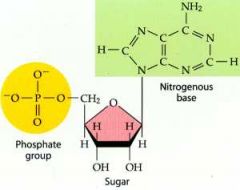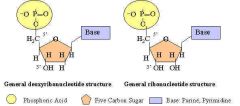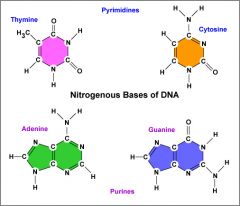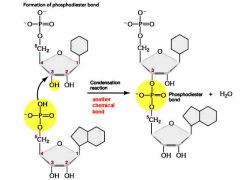![]()
![]()
![]()
Use LEFT and RIGHT arrow keys to navigate between flashcards;
Use UP and DOWN arrow keys to flip the card;
H to show hint;
A reads text to speech;
85 Cards in this Set
- Front
- Back
|
What is the general structure of nucleotides?
|

1 Nitrogenous Base
1 Pentose (Sugar) 1 Phosphate group |
|
|
What is the function of NUCLEOTIDES?
|
Nucleotides are building blocks of nucleic acids such as DNA or RNA.
|
|
|
Distinguished the difference between RIBONUCLEOTIDE (RNA) and DEOXYRIBONUCLEOTIDE (DNA)?
|

DNA and RNA are holders of genetic information, however RNA has an OH group on the 2' carbon, whereas DNA has an H group on the 2' Carbon of the pentose
|
|
|
What is the difference between a PURINE and PYRIMIDINE?
|

A purine is a nitrogenous base which as two carbon nitrogen bases. Pyrimidine only has one carbon nitrogen ring.
|
|
|
Name the two PURINES, presents in DNA and RNA?
|
Adenine
Guanine |
|
|
Name the three PYRIMIDINES present in DNA and RNA?
|
Cytosine
Thymine (DNA) /Uracil(RNA) |
|
|
How can purines and pyrimidines be modified?
|
Some contain minor bases, which are the methylated forms of the major bases, these minor bases have roles in regulating and protecting genetic information
|
|
|
Describe the phophodiester linkage in the covalent backbone of DNA and RNA?
|

Bridge between the 5' phosphate group and 3' hydroxyl group between 2 nucleotides. Both backbones are hydrophilic and therefore the backbone are alternating pentose and phosphate group. The 5' end lacks a nucleotides at the a nucleotide at the 5' position, and the 3' end lacks a nucleotide at the 3' position
|
|
|
Know the hydrogen bonding patterns in base pairs
|

Adenine interact with Thymine/Uracil through 2 hydrogen bonds
Guanine interact with Cytosine through triple hydrogen bonding |
|
|
Know the structure of DNA?
|
Consist of two helical DNA strands that runs in an complemetnary antiparrallel direction.
Hydrophilic backbones of alternating deoxyribose and phosphate groups are on the outside of the double helix facing water. Whereas the purine and pyrimidine bases are stacked inside the double helix. The offset pairing of the two strands creates a major groove and a minor groove. Hydrophobic |
|
|
What occur with DNA strands during cell divison?
|
1 parent strand splits into 2 and each parent strand combines with a new daugher strand to form a new strand.
|
|
|
DNA can occur in 3 different dimenensional for, which are?
|
B FORM
A FORM Z FORM |
|
|
Between the DNA forms, which one is the most stable?
|
B FORM
|
|
|
Between the DNA forms, which one is the longest, zigzag, skinny, and is 12 base pairs per turn?
|
Z FORMS
|
|
|
Between the 3 DNA forms, which one is favored in many solution that doesn't have water and it's wider and has 11 base pair per turn?
|
A FORM
|
|
|
Between the 3 DNA forms, which one is tilted at a 20 degree and usually crystallized in A form?
|
Z FORM
|
|
|
Define GENOTYPE and PHENOTYPE?
|
Genotype is the genetic constitution of an organism, as distinct from its physical characterisitcs. (Aa, AA, or aa)
Phenotype is the observable characteristics of an organism |
|
|
Define MUTATION?
|
An inheritable change in the nucleotide sequence of a chromosome
|
|
|
Define HOMOZYGOUS and HETEROZYGOUS?
|
Homozygous is when an organism have both copies of a given gene
Heterozygous is when an organism have two different alleles og a given gene |
|
|
Define ONE GENE-ONE ENZYME?
|
Gene is a segment of genetic material that determines or codes one enzyme
|
|
|
Who theroized the ONE GENE ONE ENZYME theory?
|
Beadle and Tatum
|
|
|
What is ONE GENE-ONE POLYPEPTIDE?
|
One gene-one polypeptide is a theory that evolved about MANY GENES CODE FOR A PROTEIN TAHT ISN'T AN ENZYME OR ONE POLYPEPTIDE
|
|
|
Define GENE?
|
Gene is all the DNA that encodes the primary sequence of some final gene product
|
|
|
Define REGULATORY SEQUENCES?
|
Regulatory sequences provide signals that may denote the beginning or end of genes.
|
|
|
What functions does REGULATORY SEQUENCES served?
|
Provide signals taht may denoted the beginning or the end of genes
Inluences the transcription of genes Function as initiation points for replication or recombination |
|
|
Define ALLELE?
|
Different version of the same gene
|
|
|
Be able to perform a simple mednelian pedigree analysis?
|
Look at HW #2
|
|
|
What is the difference between PROKARYOTIC and EUKARYOTIC gene structure?
|
Prokaryotics (bacteria)
- large, single, doubled stranded, circular DNA - contains free, extrachromosomal DNA molecules called plasmids in the free cytosol - Few bacteria contains introns Eukaryotics - More complex - 46 chromosomes - Contains introns and exons, typically more introns than exons |
|
|
What are PLASMIDS?
|
Plasmids are extrachromosomal DNA molecules separate from the chromosomal DNA, which is capable of replicating independently from the chromosmal DNA.
|
|
|
What is the difference between introns and exons?
|
Introns are intervening sequences or nontranslated DNA segments in genes
Exons are coding segments Few bacterias have introns Eukaryotics typically have more introns than exons |
|
|
How many total DNA base pairs are in E.coli (prokaryotes)? humans?
|
4,700,00
3,100,000,000 |
|
|
Approximate number of genes in E.coli (prokaryotes)? humans?
|
4,435
29,000 |
|
|
Know the important structural elements of a eukaryotic chromosome?
|
Their nucleotide sequences contain one or more intervening segments of DNA that do not code for the amino acid sequence of the polypeptide product, called introns as opposed to prokaryotic that rarely have introns. They have one gene per cell. Highly repetitive sequences in the human genome
|
|
|
What are other terms for HIGH REPETITIVE SEQUENCES?
|
SIMPLE SEQUENCE DNA
SIMPLE SEQUENCE REPEATS SATELLITE DNA |
|
|
What role does TRANSPOSONS play in human evolution?
|
Movement of transposons can lead to the redistribution of other genomic sequences
|
|
|
Define CENTROMERE and TELOMERES?
|
Centromere is a sequence of DNA that functions during cell division as an attachment point for proteins that links the chromosome to the mitotic spindle.
Telomeres are sequences at the end of eukaryotic chromosomes that help stabilize the chromosome |
|
|
What is so important about CENTROMERES?
|
This attachment is essential for the equal and orderly distribution of chromosomes sets to daughter cells .
|
|
|
Does mitochondria have DNA, and if so list them?
|
mtDNA
|
|
|
Define mtDNA?
|
mtDNA is replicated each time the mitochondrian divides before cell division by simple binary fission.
|
|
|
Can mtDNA be genetic?
|
Yes mtDNA can only passed from mother to child, in the cytoplasm of fertilized egg.
Believed to have been once an independent bacteria, later became part of the modern cell |
|
|
Define KARYOTYPE?
|
Karyotype is a map of chromosome in the nucleus of a single cell.
|
|
|
What is another term for KARYOTPE?
|
Chromosome analysis
|
|
|
What purpose does KARYOTYPE or CHROMOSOMAL ANALYSIS served?
|
Used to diagnose some types of genetic disease
Observed charcteristics (number, type, shape) of the chromosomes of an individual or species |
|
|
What purpose does KARYOTYPE or CHROMOSOMAL ANALYSIS served?
|
Used to diagnose some types of genetic disease
Observed charcteristics (number, type, shape) of the chromosomes of an individual or species |
|
|
What kind of species possess mtDNA?
|
Eukaryotics
|
|
|
Know roughly what percentage of our genome is exon vs introns vs transposons?
|
Exons 1.5%
Introns 30% Transposon 45 % |
|
|
What kind of species possess mtDNA?
|
Eukaryotics
|
|
|
What purpose does KARYOTYPE or CHROMOSOMAL ANALYSIS served?
|
Used to diagnose some types of genetic disease
Observed charcteristics (number, type, shape) of the chromosomes of an individual or species |
|
|
Know roughly what percentage of our genome is exon vs introns vs transposons?
|
Exons 1.5%
Introns 30% Transposon 45 % |
|
|
What is the HUMAN GENOME PROJECT?
|
Human genome project was an international scientific research project with the primary goal was to determine the sequence of chemical base pairs which make up DNA and to identify and map the out genes of the humane genome from both a physical and functional standpoint.
|
|
|
What kind of species possess mtDNA?
|
Eukaryotics
|
|
|
What is the HUMAN GENOME PROJECT?
|
Human genome project was an international scientific research project with the primary goal was to determine the sequence of chemical base pairs which make up DNA and to identify and map the out genes of the humane genome from both a physical and functional standpoint.
|
|
|
What kind of species did the HUMAN GENOME PROJECT use in their investigation?
|
E.coli
Fruit flies Mouse |
|
|
Know roughly what percentage of our genome is exon vs introns vs transposons?
|
Exons 1.5%
Introns 30% Transposon 45 % |
|
|
What kind of species did the HUMAN GENOME PROJECT use in their investigation?
|
E.coli
Fruit flies Mouse |
|
|
What is the HUMAN GENOME PROJECT?
|
Human genome project was an international scientific research project with the primary goal was to determine the sequence of chemical base pairs which make up DNA and to identify and map the out genes of the humane genome from both a physical and functional standpoint.
|
|
|
What kind of species did the HUMAN GENOME PROJECT use in their investigation?
|
E.coli
Fruit flies Mouse |
|
|
The genome of any given individual is unique, with the exception of which individual?
|
Identifical twins
Cloned individuals |
|
|
True or False; mapping human genome only require one copy of each gene?
|
False: human genome involves sequencing multiple variation of each gene
|
|
|
What are some of the projects that the human genome research allows us to perform?
|
Most of the current effort in identifying differences among individuals involves single nucleotide polymorphisms. Understanding how these genes express themselves will provide clues to how diseases are caused. This could mean all humans are descended from a single mother. Improved our understanding of how we evolved as humans and diverged from apes 25 millions years ago. It also tells how our body works, including the mystery behind how the sense of taste works
|
|
|
List in order the phases of INTERPHASE?
|
G1
S G2 |
|
|
List the stages of MITOSIS and what is happening during it stage?
|
Prophase: DNA condense more
Metaphase: Line up at the meta plate Anaphase: Separates Telophase: cells divison completes |
|
|
What occurs in the S phase of INTERPHASE?
|
DNA repicates and each chromosome producing two sister chromosomes (sister chromatids) remains associated with each other until after replication is completed.
|
|
|
DNA are so long, how do they maintain compaction?
|
DNA in the chromosome are very tightly associated with histones, which packag e and order the DNA into structural units called nucleosomes
|
|
|
Who theroized that DNA strands are SEMICONSERVATIVE?
|
Meselson-Stahl
|
|
|
Define SEMICONSERVATIVE REPLICATION?
|

Each DNA strand serves as template for the synthesis of a new strand, producing two new DNA molecules each with one new strand and one old (parent) strand.
|
|
|
What did Meselson-Stahal do in the experiment to yield SEMICONSERVATIVE REPLICATION?
|
Grew E.coli in both heavy nitrogen 15 and light nitrogen 14 in a medium and switch the E.coli in the opposite nitrogen medium and allow the population to grow. Results concluded both E.coli had hybrid DNA strand, one from the nitrogen 14 and one from the nitrogen 15
|
|
|
List the 3 stages of DNA replication?
|
Initiation
Elongation Termination |
|
|
What needs to happen to ACYCLOVIR before it can be active?
|
THYMIDINE KINASE needs to active and phosphorylate acyclovir to inhibit herpes
|
|
|
How DNA replication is so accurate and why is it important for DNA replication to be accurate?
|
The active site of DNA polymerase I can only accommodate certain base pair with the same geometry and will be rejected before the phosphodiester bond is form.
Proofreading: if the polymerase has added the wrong nucleotide, translocation of the enzyme to the position where the next nucleotide is to be added is inhibited. The 3'-->5' exonuclease activity removesthe mispaired nucleotide and the polymerase begins again. (Reverse of the polymerization reaction) Proofreading Base selection |
|
|
E.coli has at least how mayny DNA polymerases?
|
5
|
|
|
Function of DNA Polymerase I, II, and III?
|
DNA Polymerase I: clean up functions during replication, recombination and repair
DNA Polymerase II: enzyme needed for DNA repair DNA Polymerase III: enzyme needed for replication in E.coli |
|
|
Of the 5 DNA polymerases, which is mainly use?
|
DNA Polymerase I
|
|
|
What are Klenow fragment or Large fragment?
|
Left over fragments that retains polymerization and proofreading activities
|
|
|
Why are DNA repair systems so important?
|
Mismatch Repair
Base Excision Repair AP endonuclease |
|
|
Describe Mismatch Repair in board terms?
|
DNA mismatch repair is a system for recognizing and repairing erroneous insertion, deletion, and mis-incorporation of bases that can arise during DNA replication and recombination as well as repairing some forms of DNA damage
|
|
|
True or False: Mismatch repair is strand specific?
|
True
|
|
|
Describe BASE EXCISION REPAIR?
|
Base excision repair is a cellular mechanism taht repairs damage to DNA througout the cell cycle.
|
|
|
Identify the responsibilities of BASE EXCISION REPAIR?
|
Responsibile for removing small, non-helix distorting base lesions from the genome
|
|
|
What is so important about Base Excision Repair?
|
It is important for removing damaged bases that could otherwise cause mutations by mispairing or lead to breaks in DNA during replication
|
|
|
Which enzyme initiates BASE EXCISION REPAIR that recognize and remove specific damaged or inappropriate bases forming AP sites
|
DNA glycosylases
|
|
|
Describe NUCLEOTIDES EXCISION REPAIR?
|
DNA repair mechanism that constantly requires repair due to damage that can occur to bases from a variety of sources like chemicals or UV.
|
|
|
Why is NUCLEOTIDES EXCISION REPAIR important?
|
Cell can prevent unwanted mutations by removing the vast majority of UV induced DNA damage
|
|
|
Define Direct Repair?
|
Repair without removing a base or nucleotide
|
|
|
Define DNA photolyases?
|
Direct photoreactivation repair
|

